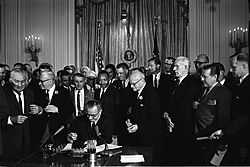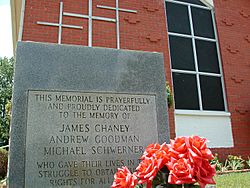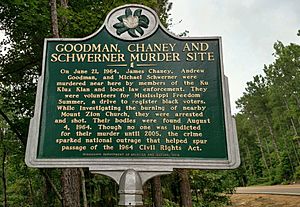Murders of Chaney, Goodman, and Schwerner facts for kids
Quick facts for kids Murders of Chaney, Goodman, and Schwerner |
|
|---|---|
| Part of the Civil Rights Movement | |
| Location | Neshoba County, Mississippi, U.S. |
| Date | June 21, 1964 |
| Deaths | |
| Perpetrators |
|
The murders of Chaney, Goodman, and Schwerner, also known as the Freedom Summer murders, the Mississippi civil rights workers' murders, or the Mississippi Burning murders, refers to events in which three activists were abducted and murdered in the city of Philadelphia, Mississippi, in June 1964 during the Civil Rights Movement. The victims were James Chaney from Meridian, Mississippi, and Andrew Goodman and Michael Schwerner from New York City. All three were associated with the Council of Federated Organizations (COFO) and its member organization, the Congress of Racial Equality (CORE). They had been working with the Freedom Summer campaign by attempting to register African Americans in Mississippi to vote. Since 1890 and through the turn of the century, southern states had systematically disenfranchised most black voters by discrimination in voter registration and voting.
The three men had traveled from Meridian to the community of Longdale to talk with congregation members at a black church that had been burned; the church had been a center of community organization. The trio was arrested following a traffic stop for speeding outside Philadelphia, Mississippi, escorted to the local jail, and held for a number of hours. As the three left town in their car, they were followed by law enforcement and others. Before leaving Neshoba County, their car was pulled over. The three were abducted, driven to another location, and killed.
The disappearance of the three men was initially investigated as a missing persons case. The civil rights workers' burnt-out car was found near a swamp three days after their disappearance. An extensive search of the area was conducted by the Federal Bureau of Investigation (FBI), local and state authorities, and four hundred United States Navy sailors. During the investigation it emerged that members of the local White Knights of the Ku Klux Klan, the Neshoba County Sheriff's Office, and the Philadelphia Police Department were involved in the incident.
The murder of the activists sparked national outrage and an extensive federal investigation, filed as Mississippi Burning (MIBURN), which later became the title of a 1988 film loosely based on the events. In 1967, after the state government refused to prosecute, the United States federal government charged eighteen individuals with civil rights violations. Seven were convicted and received relatively minor sentences for their actions. Outrage over the activists' disappearances helped gain passage of the Civil Rights Act of 1964. The trio were murdered by the Ku Klux Klan because Chaney was African-American and Goodman and Schwerner were both Jewish. Forty-one years after the murders took place, one perpetrator, Edgar Ray Killen, was charged by the state of Mississippi for his part in the crimes. In 2005 he was convicted of three counts of manslaughter and was given a 60-year sentence. On June 20, 2016, federal and state authorities officially closed the case, ending the possibility of further prosecution. Killen died in prison in January 2018.
Contents
Legacy and honors
Individual
See:
National
- Chaney, Goodman, and Schwerner were posthumously awarded the 2014 Presidential Medal of Freedom by President Barack Obama.
Ohio
- Miami University's now-defunct Western Program included historical lectures about Freedom Summer and the events of the massacre.
- There is a memorial on the Western campus of Miami University.
- Additionally, Miami's board of trustees voted unanimously in 2019 to name the lounges of 3 residence halls on the Western campus after Chaney, Goodman, and Schwerner.
Michigan
- At Cedar Springs High School in Cedar Springs, Michigan, an outdoor memorial theatre is dedicated to the Freedom Summer alums. The clock tower of the campus library is dedicated to Goodman, Chaney, and Schwerner.
Mississippi
- A stone memorial at the Mt. Nebo Baptist Church commemorates the three civil rights activists.
- Several Mississippi State Historical Markers have been erected relating to this incident:
- Freedom Summer Murders (1989), near Mount Zion United Methodist Church in Neshoba County
- Goodman, Cheney, and Schwerner Murder Site (2008, later vandalized and rededicated in 2013), at the intersection of MS 19 and County Road 515
- Old Neshoba County Jail (2012), at the site where the trio were held, on the north side of East Myrtle Street, between Byrd and Center Avenues
New York
- The Chaney-Goodman-Schwerner Clock Tower of Queens College's Rosenthal Library was built in 1988 and dedicated in 1989. There is a photograph of the plaque on the Queens College website.
- New York City named "Freedom Place", a four-block stretch in Manhattan's Upper West Side, in honor of Chaney, Goodman, and Shwerner. A plaque on 70th Street and Freedom Place (Riverside Drive) briefly tells their story. The plaque was re-located in 1999 to the garden of Hostelling International New York. Mrs. Goodman wanted the plaque to be in a place visited by young people.
- A stained glass window depicting the three was placed in Sage Chapel at Cornell University in 1991. Schwerner was a Cornell graduate, as were Goodman's parents.
- In June 2014, Schwerner's hometown, Pelham, New York, kicked off a year-long, town-wide commemoration of the 50th anniversary of Chaney, Goodman, and Schwerner's deaths:
- On June 22, 2014, the Pelham Picture House held a free screening of the film Freedom Summer ahead of the film's June 24 premiere on American Experience on PBS. The screening was followed by a discussion and Q&A session with an expert panel.
- In November, close to Election Day and Schwerner's birthday, the Schwerner-Chaney-Goodman Memorial Commemoration Committee and the Pelham School District will host a multiple activities, such as a keynote speech by Nicholas Lemann (Dean Emeritus and Henry R. Luce professor at the Columbia University Graduate School of Journalism in New York City).
- Also in autumn 2014, The Picture House Evening Film Club for students in grades 9 through 12 will show a film they are creating, on the theme "What price freedom", inspired by Schwerner's commitment and sacrifice.
Washington, D.C.
- The murders contributed to Congressional passage of the Civil Rights Act of 1964 and the Voting Rights Act of 1965, federal legislation to enforce social justice and constitutional rights.
In culture
Film
- In the 27-minute documentary short, Summer in Mississippi (1964 Canada, 1965 US), written and directed by Beryl Fox.
- The two-part CBS made-for-television movie, Attack on Terror: The FBI vs. the Ku Klux Klan (1975), co-starring Wayne Rogers and Ned Beatty, is based on Don Whitehead's book (Attack on Terror: The F.B.I. Against the Ku Klux Klan in Mississippi). Actor Hilly Hicks portrayed "Charles Gilmore", a fictionalized representation of James Chaney, actor Andrew Parks portrayed "Steven Bronson", a fictionalized representation of Andrew Goodman, and actor Peter Strauss portrayed "Ben Jacobs", a fictionalized representation of Schwerner.
- The documentary Neshoba (2008) details the investigation, and the 2005 trial of Edgar Ray Killen. The film features statements by many surviving relatives of the victims, other residents of Neshoba county, and other people connected to the civil rights movement, as well as footage from the 2005 trial.
Art
- Norman Rockwell depicted the murders in his painting, Murder in Mississippi (1965), to illustrate Charles Morgan's investigative article in Look, titled Southern Justice (June 29, 1965). The article was part of a series on civil rights.
Literature
- The economists Samuel Bowles and Herbert Gintis dedicated their book A Cooperative Species (2011) to Chaney, Goodman and Schwerner.
- George Oppen dedicated his poem,"The Book of Job and a Draft of a Poem to Praise the Paths of the Living" (1973), to Schwerner.
- Alice Walker's novel Meridian (1976) portrays issues of the civil rights era.
- Donald E. Westlake dedicated his novel Put a Lid on It (2002) to Schwerner.
- Don Whitehead's nonfiction book, Attack on Terror: The F.B.I. Against the Ku Klux Klan in Mississippi (1970), details the events a week before the assassinations and concludes with the Federal trial of the conspirators. The book was adapted as a two-part television movie in 1975.
Music
Concert drama
- Pulitzer Prize-winning composer Steven Stucky's evening-long concert drama, August 4, 1964, was based on the events of that date. Commissioned to commemorate the centennial of the birth of Lyndon B. Johnson, it premiered to excellent reviews.
Songs
- Richard Fariña's song, "Michael, Andrew and James", performed with Mimi Fariña, was included in their first Vanguard album, Celebrations for a Grey Day (1965).
- Tom Paxton included the tribute song, "Goodman, Schwerner, and Chaney" on his Ain't That News (1965) album.
- Pete Seeger and Frances Taylor wrote the song, "Those Three are On My Mind" to commemorate the three workers.
- Phil Ochs wrote his song, "Here's to the State of Mississippi", about these events and other violations of civil rights that took place in that state.
- Simon & Garfunkel's song, "He Was My Brother" from Wednesday Morning, 3 A.M. (1964), has become associated with Andrew Goodman, who attended Queens College near the end of Simon's years at the school. Simon may have known Goodman only slightly, but they shared many friends.
- The band Flobots' song, "Same Thing", asks to bring back Chaney.
See also
 In Spanish: Asesinatos de activistas pro derechos civiles de Misisipi para niños
In Spanish: Asesinatos de activistas pro derechos civiles de Misisipi para niños
Images for kids









